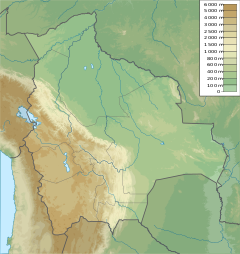
Back پاريناكوتا ARZ Parina Quta (Chili-Wuliwya) Aymara Parinacota BAR Парынакота Byelorussian Парынакота BE-X-OLD Parinacota (vulkan) BS Parinacota Catalan Cerro Parinacota CEB Parinacota Czech Parinacota Danish
| Parinacota Parina Quta | |
|---|---|
 Parinacota and Chungará Lake | |
| Highest point | |
| Elevation | 6,380 m (20,930 ft)[1] |
| Listing | Ultra |
| Coordinates | 18°09′58″S 69°08′31″W / 18.166°S 69.142°W[2] |
| Geography | |
| Location | Bolivia – Chile border |
| Parent range | Andes |
| Geology | |
| Mountain type | Stratovolcano |
| Volcanic arc/belt | Central Volcanic Zone |
| Last eruption | 290 CE ± 300 years |
| Climbing | |
| First ascent | 1928 |
| Easiest route | snow/rock scramble |
Parinacota (in Hispanicized spelling), Parina Quta or Parinaquta is a dormant stratovolcano on the border of Bolivia and Chile. Together with Pomerape it forms the Nevados de Payachata volcanic chain. Part of the Central Volcanic Zone of the Andes, its summit reaches an elevation of 6,380 metres (20,930 ft) above sea level. The symmetrical cone is capped by a summit crater with widths of 1 kilometre (0.62 mi) or 1,000 metres (3,300 ft). Farther down on the southern slopes lie three parasitic centres known as the Ajata cones. These cones have generated lava flows. The volcano overlies a platform formed by lava domes and andesitic lava flows.
The volcano started growing during the Pleistocene and formed a large cone. At some point between the Pleistocene and the Holocene, the western flank of the volcano collapsed, generating a giant landslide that spread west and formed a large, hummocky landslide deposit. The avalanche crossed and dammed a previously existing drainage, impounding or enlarging Lake Chungará; numerous other lakes now forming the headwaters of the Rio Lauca sprang up within the deposit. Volcanic activity rebuilt the cone after the collapse, cancelling out the collapse scar.
Parinacota had numerous effusive and explosive eruptions during the Holocene, the latest about 200 years ago. While there are no recorded eruptions, legends of the local Aymara people imply that they may have witnessed one eruption. Renewed activity at Parinacota is possible in the future, although the relatively low population density in the region would limit potential damage. Some towns and a regional highway between Bolivia and Chile are potentially exposed to the effects of a new eruption.
- ^ Davidson et al. 1990, p. 413.
- ^ Cite error: The named reference
GVPwas invoked but never defined (see the help page).
